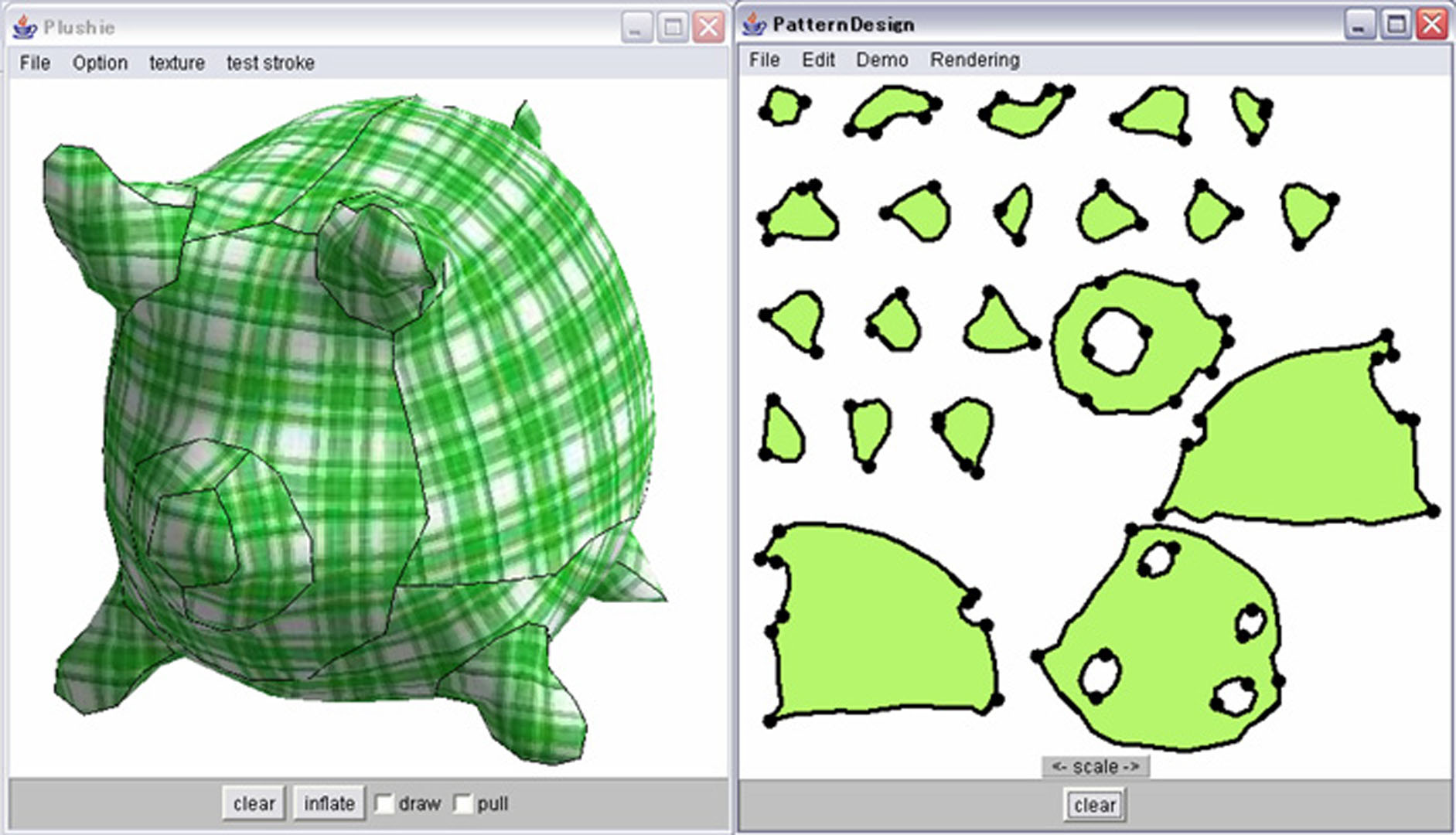“Plushie: an interactive design system for plush toys” by Mori and Igarashi
Conference:
Type(s):
Title:
- Plushie: an interactive design system for plush toys
Presenter(s)/Author(s):
Abstract:
We introduce Plushie, an interactive system that allows nonprofessional users to design their own original plush toys. To design a plush toy, one needs to construct an appropriate two-dimensional (2D) pattern. However, it is difficult for non-professional users to appropriately design a 2D pattern. Some recent systems automatically generate a 2D pattern for a given three-dimensional (3D) model, but constructing a 3D model is itself a challenge. Furthermore, an arbitrary 3D model cannot necessarily be realized as a real plush toy, and the final sewn result can be very different from the original 3D model. We avoid this mismatch by constructing appropriate 2D patterns and applying simple physical simulation to it on the fly during 3D modeling. In this way, the model on the screen is always a good approximation of the final sewn result, which makes the design process much more efficient. We use a sketching interface for 3D modeling and also provide various editing operations tailored for plush toy design. Internally, the system constructs a 2D cloth pattern in such a way that the simulation result matches the user’s input stroke. Our goal is to show that relatively simple algorithms can provide fast, satisfactory results to the user whereas the pursuit of optimal layout and simulation accuracy lies outside this paper’s scope. We successfully demonstrated that non-professional users could design plush toys or balloon easily using Plushie.
References:
1. Agrawala, M., Doantam, P., Heiser, J., Haymaker, J., Klingner, J., Hanrahan, P., and Tversky, B. 2003. Designing effective step-by-step assembly instructions. ACM Transactions on Graphics (Proceedings of SIGGRAPH 2003) 22, 3, 828–837. Google ScholarDigital Library
2. Breen, D. E., House, D. H., and Wozny, M. J. 1994. Predicting the drape of woven cloth using interacting particles. In Proceedings of SIGGRAPH 1994, 365–372. Google ScholarDigital Library
3. Bruno, L., Sylvain, P., Nicolas, R., and Jerome, M. 2002. Least squares conformal maps for automatic texture atlas generation. ACM SIGGRAPH 02, 362–371. Google ScholarDigital Library
4. Choi, K. J., and Ko, H. S. 2002. Stable but responsive cloth. ACM Transactions on Graphics (Proceedings of SIGGRAPH 2002) 21, 3, 81–97. Google ScholarDigital Library
5. Decaudin, P., Julius, D., Wither, J., Boissieux, L., Sheffer, A., and Cani, M. P. 2006. Virtual garments: A fully geometric approach for clothing design. Computer Graphics Forum (Proceedings of Eurographics 2006) 25, 3, 625–634.Google Scholar
6. Desbrun, M., Schröder, P., and Barr, A. 1999. Interactive animation of structured deformable objects. In Proceedings of Graphics Interface 1999, 1–8. Google ScholarDigital Library
7. Grinspun, E., Krisl, P., and Schröder, P. 2002. Charms: A [email protected] for adaptive simulation. ACM Transactions on Graphics (Proceedings of SIGGRAPH 2002) 21, 3, 281–290. Google ScholarDigital Library
8. Igarashi, T., and Hughes, J. F. 2001. A suggestive interface for 3d drawing. In Proceedings of 14th Annual Symposium on User Interface Software and Technology (ACM UIST 2001), 173–181. Google ScholarDigital Library
9. Igarashi, T., and Hughes, J. F. 2002. Clothing manipulation. In Proceedings of 15th Annual Symposium on User Interface Software and Technology (ACM UIST 2002), 91–100. Google ScholarDigital Library
10. Igarashi, T., Matsuoka, S., and Tanaka, H. 1999. Teddy: A sketching interface for 3d freeform design. In ACM SIGGRAPH 1999, 409–416. Google ScholarDigital Library
11. Igarashi, T., Moscovich, T., and Hughes, J. F. 2005. As-rigid-as-possible shape manipulation. ACM Transactions on Computer Graphics (ACM SIGGRAPH 2005) 24, 3, 1134–1141. Google ScholarDigital Library
12. Julius, D., Kraevoy, V., and Sheffer, A. 2005. D-charts: quasi developable mesh segmentation. Computer Graphics Forum. (Proceedings of Eurographics 2005) 24, 3, 981–990.Google Scholar
13. Karpenko, O. A., and Hughes, J. F. 2006. Smoothsketch: 3d free-form shapes from complex sketches. ACM Transactions on Graphics (Proceedings of SIGGRAPH 2006) 22, 3, 589–598. Google ScholarDigital Library
14. Masry, M., and Lipson, H. 2005. A sketch-based interface for iterative design and analysis of 3d objects. In Proceedings of Eurographics Workshop on Sketch-Based Interfaces, 109–118. Google ScholarDigital Library
15. Milenkovic, V. J. 1999. Rotational polygon containment and minimum enclosure using only robust 2d constructions. Computational Geometry 13, 1, 3–19. Google ScholarDigital Library
16. Mitani, J., and Suzuki, H. 2004. Making papercraft toys from meshes using strip-based approximate unfolding. ACM Transactions on Graphics (Proceedings of SIGGRAPH 2004) 23, 3, 259–263. Google ScholarDigital Library
17. Mori, Y., and Igarashi, T. 2006. Pillow: Interactive pattern design for plush toys. In DVD publication at SIGGRAPH 2006 Sketches & Applications. Google ScholarDigital Library
18. Shatz, I., Tal, A., and Leifman, G. 2006. Paper craft models from meshes. The Visual Computer: International Journal of Computer Graphics (Proceedings of Pacific Graphics 2006) 22, 9, 825–834. Google ScholarDigital Library
19. Sheffer, A., Lévy, B., Mogilnitsky, M., and Bogomyakov, A. 2005. ABF++: Fast and robust angle based flattening. ACM Transactions on Graphics 24, 2, 311–330. Google ScholarDigital Library





